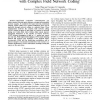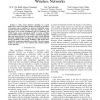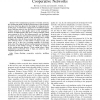CISS
2007
IEEE
14 years 5 months ago
2007
IEEE
Relay-based cooperative communications can achieve spatial diversity gains, enhance coverage and potentially increase capacity. If considered for large networks, traditional relayi...
CISS
2007
IEEE
14 years 5 months ago
2007
IEEE
—We consider a cooperative diversity scheme where a relay cooperatively enhances communication between a source and destination. In cooperative diversity, due to lack of a mechan...
CISS
2007
IEEE
14 years 5 months ago
2007
IEEE
Abstract— We propose a framework to mitigate the interference in high data rate mobile wireless networking. Interference is a fundamental obstacle to achieve high data rates in w...
CISS
2007
IEEE
14 years 5 months ago
2007
IEEE
— The problem of detecting encrypted information flows using timing information is considered. An information flow consists of both information-carrying packets and irrelevant ...
CISS
2007
IEEE
14 years 5 months ago
2007
IEEE
A video sensor platform consisting of a smart image sensor with focal plane motion processing is presented. The camera node is intended for ultra-low bandwidth ad-hoc wireless netw...
CISS
2007
IEEE
14 years 5 months ago
2007
IEEE
In this paper we examine possible ways that feedback can be used, in the context of systems with network coding capabilities. We illustrate, through a number of simple examples, th...
CISS
2007
IEEE
14 years 5 months ago
2007
IEEE
Limiting capabilities of practical recognition systems are determined by a variety of factors that include source encoding techniques, quality of images, complexity of underlying ...
CISS
2007
IEEE
14 years 5 months ago
2007
IEEE
— We study the case of a single transmitter, which communicates to two co-located users, through an independent block Rayleigh fading channel. The co-location nature of the users...
CISS
2007
IEEE
14 years 5 months ago
2007
IEEE
— Two fundamental properties of wireless networks, the variable link quality and the broadcast nature of the transmission, have often been ignored in the design of routing protoc...
CISS
2007
IEEE
14 years 5 months ago
2007
IEEE
— In wireless ad hoc networks, distributed nodes can collaboratively form an antenna array for long-distance communications to achieve high energy efficiency. In recent work, Oc...



